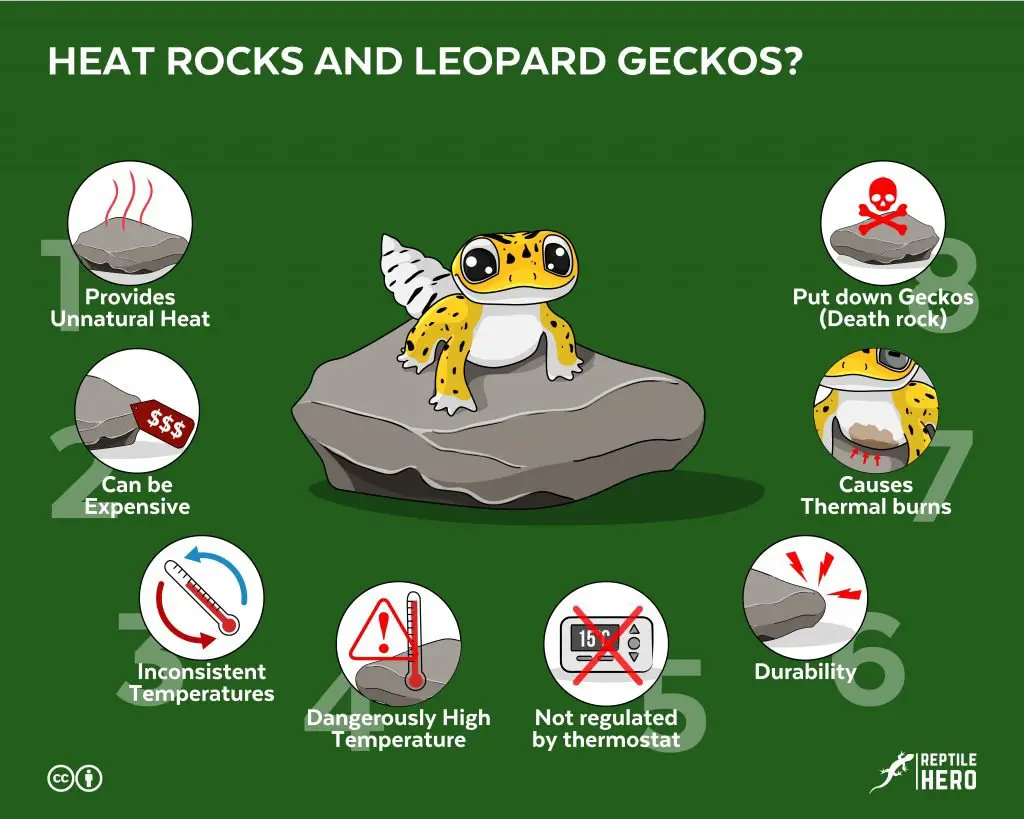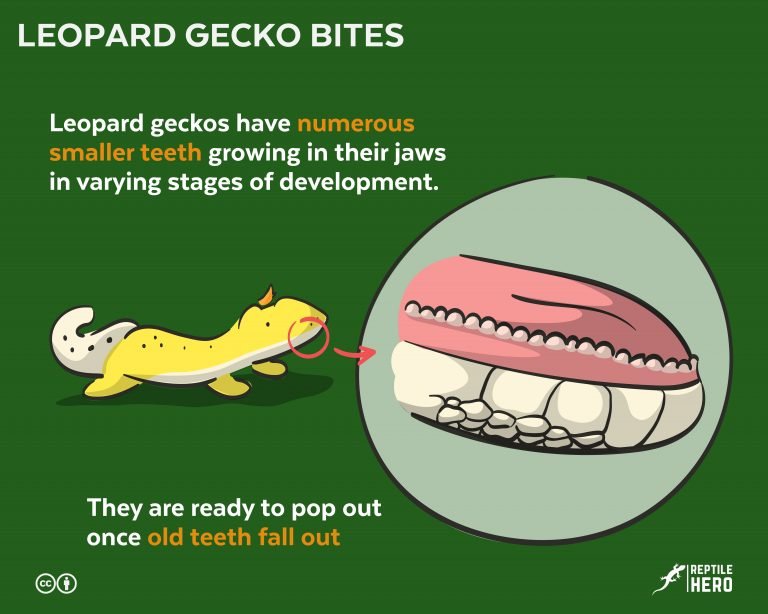Are Heat Rocks Bad for Leopard Geckos? What’s the Deal With Them?
Heat rocks, also known as hot rocks, have become extremely notorious within the reptile-keeping community over the years – burns, hot spots, fires. But is all the hate it’s getting actually reasonable or is it all just due to social media exposure? Well, we have science to answer that!
As a whole, the use of electric reptile heat rocks is not recommended by most reptile experts including herpetologists and veterinary doctors. In fact, there have been numerous reports of hot rocks causing serious thermal burns and even death in leopard geckos and many other ectothermic reptiles.
Read this and become a rock star when it comes to proper heating and general husbandry!
Reptile Heat Rocks: What Are They?
Heat rocks used to be regarded as quintessential products when it comes to providing ample heat for reptiles and amphibians alike. Through the years, not much has changed with how and what they are built with but their reputation has taken a huge blow. But before we discuss the why, let us first find out the what.

What are Reptile Heat Rocks Made of?
The average electric reptile heat rock is mainly made from a thermally conductive exterior, like plastic or concrete, that provides full coverage for a heating element, such as Nichrome wires.
In terms of build, heat rocks are highly comparable with heat mats or under-tank heaters. There is a heating element sandwiched between two panels of a protective material that is non-toxic and water-resistant. Also, it may or may not have a small light that serves as a power indicator.
For the heating element, there is a lot less to the specific type used for the production of hot rocks [1]. Some manufacturers use panels, others use coils, and all the rest use cables or wires. However, by and large, Nichrome wire seems to be the most common choice of heating element for makers or hot rocks.
Nichrome wire, as the name suggests, is an admixture of primarily nickel and chromium. At times, this may contain some amounts of iron as well. It is highly resistant to heat and oxidation making it a great option for a number of products (e.g. toasters) that need a reliable and durable heating element.

Materials used to house the heating element in a hot rock include the following:
- Food-grade resin
- Ceramic/clay
- Plaster
- Heavy-molded plastic
- Concrete/Cement
- Hydrated rock materials
Once plugged into a regular electrical strip, power bank, or wall socket, the heat from the heating element will also cause the exterior to warm up. Ideally, it should be placed in your leopard gecko’s warm side to maintain optimal thermal gradient. Then, when your adorable scaly baby needs to warm up, he or she could simply lay on top of it to steadily and safely absorb the heat through direct skin contact or conduction [2]. At least, that’s what their creators intended them to do.
What are the Usual Features of Reptile Heat Rocks?
A heat rock is a lightweight, low-powered heating device designed for use with thigmothermic ectothermic animals which do not commonly bask under direct sunlight for prolonged periods of time. It comes in a variety of sizes, shapes, and colors as well. However, although they typically have low power ratings (expressed in Watts or W), they may reach temperatures of more or less 100°F (38°C).
The power rating of most, if not all, hot rocks marketed towards reptile-keepers fall in the range of 5 to 15 Watts. Bigger rocks consume more power to work properly and are heavier, though never going over 12 sq. in. (30 sq. cm.) and 10 pounds (5 kilograms). But regardless of size, they can heat up to 100 °F (38°C) or higher.
Although this fact may seem completely irrelevant or unnecessary to some, this actually affects how much you will have to spend on your leopard gecko’s monthly electricity bill. Low-powered devices will consume much less electrical energy than high-powered devices even when operating for the same number of hours.
Personally, I think this is why heat rocks rose greatly in popularity back then. About a decade or two ago, people kept leopard geckos in tiny 10-gallon tanks in pairs with minimal (now considered substandard) set-ups, and saving on costs was prioritized over updated husbandry practices. But with the overgrowing push for science-based reptile welfare, the problems with electric hot rocks have come to light.
What are the Pros and Cons of Reptile Heat Rocks?
Generally speaking, the 3 benefits that come with using electric reptile heat rocks for leopard geckos are easily outweighed by the 8 disadvantages and risks they may cause – which, in severe cases, includes death.
The 3 Pros of Using Heat Rocks for Leopard Geckos
Imitates natural rocks warmed up by the sun.
Heat rocks provide leopard geckos with heat in the form of long-wavelength infrared radiation or infrared C (IR-C).
Has low energy consumption and electricity costs.
Since they operate on low wattage ratings, they are a highly energy-efficient heating device for reptiles
The protective facade is identical to natural rocks.
Unlike the plain and practical heat mats, hot rocks look much more aesthetically pleasing as they are available in a variety of designs (i.e., color, shape, size) that allow them to blend nicely into a basic naturalistic set-up.
The 8 Cons of Using Heat Rocks for Leopard Geckos
These products provide constant but unnatural heat.
Even though IR-C is normally found in the natural habitat of leopard geckos, the IR-C emitted by the ground, rocks, trees, and other organic materials ordinarily gradually dissipates.
Furthermore, this type of heat is not sufficient to warm up a reptile to its very core for optimal body functioning (e.g., digestion, locomotion). It cannot even heat up at least 1/3 of an enclosure, it can only heat up what is close to and directly around it.
Electric reptile hot rocks are expensive.
Surprisingly, these things can fetch quite a high price despite not being a good primary, let alone secondary, heat source. As a matter of fact, many reputable companies that offer heat rocks do readily state in their packaging that these must never be used as either a sole or a primary heating device.
Unfortunately, there are a few more affordable no-name-brand units that offer little to no such warnings – I have even come across a few that didn’t have proper packaging nor adequate product information.
Inconsistent surface temperatures across the artificial rock facade.
Now, you might think that once an electric reptile hot rock is marketed to not have hot spots but sadly that couldn’t be any farther from the truth – even for branded heat rocks.
A close friend of mine once tried and tested 3 heat rocks from different stores and manufacturers to see whether there is one that actually provides consistent and stable heat. He had high hopes that at least one would prove its claims true. However, all 3 products had different temperature readings across their surface.

More specifically, parts with thicker coverings were cooler (80-95°F or 27-35°C) while thinner portions were much hotter (over 100°F or 38°). This is true even for hot rocks that were relatively flat and even, so the problem may also lie with the way the heating cable was distributed within the product.
Temperatures can get dangerously high.
Besides having inconsistent surface temperatures, heat rocks are also infamous for reaching fatally high temperatures for our small little leopard geckos. Even without the issue of thermal blocking, they can get as hot as 125°F (52°C) which is considerably hot to the touch – and if it’s hot for you, it will be scalding for your cold-blooded baby.
Sure, there are incredibly rare models that have a compact dial along the cord for manual temperature adjustment, but these are extremely hard to find. Even then, they don’t have accurate readings and displays for temperature readings. The knob or dial would normally only have the words low, medium, and high, not exact numbers.
A hot rock cannot be regulated properly even with a thermostat.
Some heat rocks are said to have built-in systems for temperature regulation, however, this is almost always not the case.
Remember the heating element is securely encased inside the hot rock. Because of this, it is impossible to get a precise reading for a heat rock’s temperature and regulate them accordingly with a thermostat.
Despite having been made to look like a rock, it is not as durable.
To be totally honest with you, I never personally tried using a hot rock for my leopard gecko before. One of the main reasons is because the few people I knew who have used them had nothing but bad opinions of it, and this includes the fact that they easily break.
Hot rocks ordinarily fall apart and malfunction after just a few weeks of use – at least that’s what I and many other reptile-keepers have observed so far. What’s worse is that when they malfunction, they do so and continuously operate, reaching dangerous temperatures over 125°F (52°C).
Has caused significant thermal burns in leopard geckos.
Heat rocks are among the main culprit causes of thermal burns in reptiles [2, 3]. They have caused significant skin and muscle damage as well as permanent deformities not jor in leopard geckos but bigger reptiles too.
In worst-case scenarios, hot rocks have put down numerous geckos.
A big part as to why heat rocks now have the incredibly bad reputation that they do is because even exotic vets have noted several instances where they cause the death of leopard geckos, among many other commonly kept reptiles. Hence the horrendous nickname, death rock.
Considering all these cons, I still have no clue as to why heat rocks are continuously produced by big companies and sold in local exotic pet shops and online stores – that is, if we don’t include profit into the equation.
Can You Warm Up Heat Rocks in the Microwave?
No, it is never safe to place anything that runs on electricity and is made of metal inside a microwave oven. Doing so will put you and your pet in life-threatening danger. So a heat rock should never be warmed up in a microwave.
Remember that one microwave scene in American Hustle? If you don’t know or can’t remember what I’m talking about, watch this short clip:
Basically, anything with metal won’t fare well in a microwave oven [4]. Microwave radiation effectively heats up moist food and will readily pass through certain materials (e.g. plastic, glass). Metal, however, can easily heat up (as the microwave can induce electric currents in it) resulting in sparks, popping, and miniature lightning bolts inside. Placing metallic objects may even bring about the collapse of your house due to fire.
Can you use a normal rock, heat it in the microwave, and place it in the tank?
Heating natural rocks, especially wet ones, in a microwave oven is not recommended either as doing so will cause the rock to explode as well. A safer way to heat rocks for use as emergency heaters, for example in case of a power outage, is to bring a pot of water to a boil, turn it off, place the rock in the pot, then place it in a thick clean sock.
Electric Heat Rocks and Heat Recognition
In theory, heat rocks can imitate how natural rocks retain heat. They capture the infrared radiation of sunlight and gradually release it once the sun has set. However, all commercially available electric reptile hot rocks are incapable of executing this as they can neither be accurately controlled nor regulated. Lastly, heat recognition of reptiles is neither widely understood nor well-researched.
Wild reptiles, including leopard geckos, are able to obtain and maintain optimal core temperatures through 3 ways in particular: 1) radiant heat from the sun, 2) convective heat with warm air, and 3) conductive heat from warm surfaces like stones and trees [2]. Hot rocks aim to replicate the last heating method but fail to do so effectively.
Instead of gradually cooling down as the leopard gecko sitting on top of it absorbs heat through its skin, it is either constantly hot or significantly heats up as time passes. Interestingly though, even though reptiles seem to have the ability to recognize heat, they don’t readily react to incredibly hot electric heat rocks.
A possible explanation for a leopard gecko’s lack of pain reflex with abnormally hot heat rocks is that IR-C is simply not deep-penetrating heat. Even at elevated temperatures, IR-C only penetrates the outermost layer of the skin, as such, the reptile may be unable to process deadly levels of IR-C since it doesn’t significantly raise their core temperature accordingly [5].
Scientists have also theorized that reptiles, as a whole, have different pain receptors we have yet to study in great detail which may be completely different from what mammals pose [3]. Such knowledge may help us explain their pain and/or withdrawal reflex, or lack thereof, and provide a factual basis for creating much safer and more effective heat rocks.
Can You Make a Heat Rock for Your Leopard Gecko?
The easiest and safest way to make a non-electrical, water-safe, non-toxic hot rock for a leopard gecko is to simply place a clean piece of flat rock right under a heating lamp. By doing so, the keeper can almost perfectly imitate how an ordinary sun-warmed rock helps a gecko stay warm during the night.
Here’s the whole truth: you can make a good, reliable, and safe heat rock in a matter of seconds by simply placing a slab of smooth and disinfected natural rock or stone tile underneath the center of your pet leopard gecko’s heat lamp. It won’t get dangerously hot as long as your lamp is regulated by a great quality thermostat and it isn’t too close to the vivarium floor.
Plus, similar to how sun-warmed rocks behave in the wilderness, the absorbed IR during the day will slowly be released once it’s dark. Meaning, it won’t reach fatally high temperatures. Then, when the next day comes, this natural cycle will repeat again and again.
Safe stone materials for leopard geckos include:
- Limestone
- Sandstone
- Granite
- Slate (here on Amazon)
- Quartz
- Flagstone
- River rocks
Other commercially available options include ceramic and terracotta tiles or thin slabs can do the trick too. Just make sure to keep in mind that colors also play a huge part in the material’s ability to absorb or reflect heat. Watch the quick video below for an actual demonstration of this:
Typically, darker objects (e.g. black slate slab) absorb heat much better than lighter objects (e.g., a light reddish brown tile). So if you are having problems with the slab getting too hot, replace it with a lighter one and vice versa.
If rock slabs and tiles are really safe, why do they have a California Proposition 65 warning?
The California Proposition 65 warning for rock and similar materials are likely due to their natural silica or silicon dioxide content [6,7]. However, unless you are regularly inhaling copious amounts of incredibly fine particles of silica for long periods, you are not at significant risk of developing cancer from your exposure.
Takeaways
Commercially available hot rocks used for leopard geckos and similar reptiles are usually just a heating element completely encased in a thermally conductive material.
The pros of using electric heat rocks for leopard geckos include 1) warmth, 2) energy and electricity savings, and 3) naturalistic looks. However, there are far more cons to its use such as 1) unnatural warmth, 2) overpricing, 3) irregular heat, 4) high temperatures, 5) thermostat incompatibility, 6) poor quality, 7) burns, and 8) death.
A better, more natural way to keep your gecko warm enough at night without an electric nighttime heating source is to place a thin slab of thermally conductive rock beneath a heat lamp during the day. Once the sun goes down, this rock will reradiate the heat it has retained until your timed heat lamp is set to operate again.
Sources
[1] https://sciencing.com/nichrome-wire-used-for-5871336.html
[2] https://www.dvm360.com/view/understanding-thermal-burns-reptile-patients-proceedings
[3] https://veterinary-practice.com/article/wound-management-in-reptiles
[5] https://www.animalsathomenetwork.com/wp-content/uploads/2020/09/InfraRed-Heating-for-Reptiles.pdf
[6] https://oehha.ca.gov/proposition-65/chemicals/silica-crystalline-airborne-particles-respirable-size


![Deep Heat Projectors For Leopard Geckos? [Final Guide]](https://www.reptilehero.com/wp-content/uploads/2021/08/gecko-deep-heat-projector-small-cover-infographic.jpg)

![Can You Place Your Gecko In A Hamster Ball? [Bad Idea]](https://www.reptilehero.com/wp-content/uploads/2021/01/Gecko-Hamster-Ball-cc-768x614.jpg)
![Taking Care of Geckos During Power Outages [Final Guide]](https://www.reptilehero.com/wp-content/uploads/2021/04/Gecko-Care-Power-Outage-768x614.jpg)
![How Do Geckos Walk on Walls? [With Science]](https://www.reptilehero.com/wp-content/uploads/2021/10/G44_-_Redesign-768x614.jpg)
